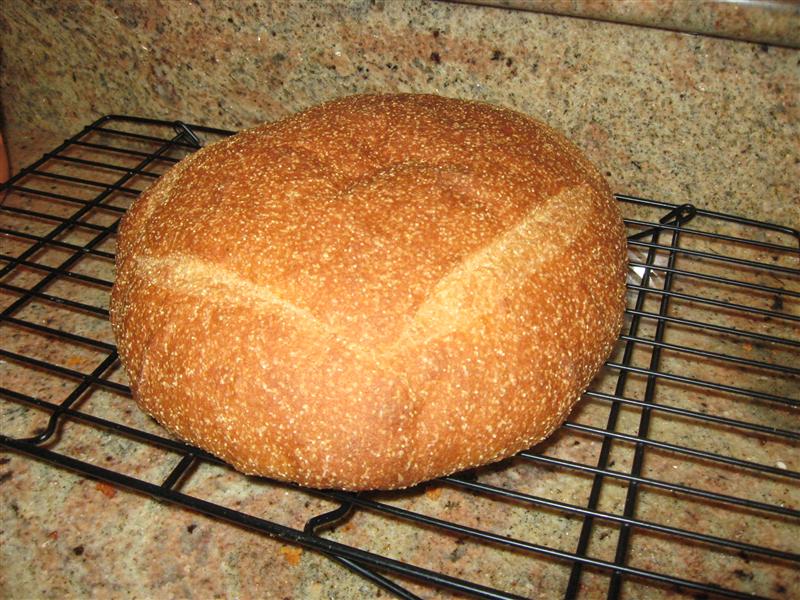Living in a part of the world with a fair number of Portuguese folks living here, I've heard of and read about broa bread, but I haven't been able to find a "gold standard" in any local bakery to compare to. I found a broa bread in a Portuguese restaurant, but it was more like a heavy biscuit than a corny, slightly sweetish loaf I've been led to believe it is. So I thought I'd share my latest experiment with the keeners here at TFL to see what you have to say.
Given the good track record of King Arthur Flour, I thought I'd try its rendition of broa bread - here's what the formula ends up looking like for an 850 gram test loaf:
| Weight | Bakers % | 850 | |
| AP flour | 10.75 | 72.3 | 334.3 |
| Hot water | 6 | 40.3 | 186.6 |
| Cornmeal | 4.125 | 27.7 | 128.3 |
| Milk (warmed) | 4 | 26.9 | 124.4 |
| Honey | 1.25 | 8.4 | 38.9 |
| Salt | 0.564 | 3.0 | 13.9 |
| Olive oil | 0.48 | 3.2 | 14.9 |
| Instant yeast | 0.282 | 1.9 | 8.8 |
| 183.8 |
I followed the recipe exactly, and got a very soft dough - I had to start processing it using Bertinet's flipping technique until it came together a bit - with a bit of graininess from the cornmeal.
Here's what the loaf looked like ....
and here's what the crumb looked like:
Good taste (nowhere near as sweet as I thought it might be, given the honey in it), with a fine-ish crumb (to be expected given the oil and milk in it) and just a bit of crunch from the cornmeal (but not too much because of the initial soaking). I'd make some more down the road as a corny alternative to my usual home baking.
So, anybody here seen/eaten REAL broa bread (ideally, in the old country) to give me an assessment, good, bad or ugly? I wouldn't mind giving some away to some Portuguese people I know, but I want to know how close this may or may not be to the "real" thing.
Thanks in advance.
- foodslut's Blog
- Log in or register to post comments
your photos didn't appear.
Let's try again, since the system won't let me edit my original - here's the KAF recipe, and here's the pix of my version...
A nice bread, Foodslut, but I'm afraid it does not look like the real thing.
There are many variations of the broa in Portugal and Galicia (North West Spain), but all of them are made with a high proportion of cornmeal. Many (all?) recipes add rye flour, and most of them a little wheat flour, too. Of course, the crumb is not at all like a common wheat bread; it's compact and very moist. The crumb of the famous broa de Avintes has an almost pâté-like texture. It's not for everyone's tastes :)
Mouette Barboff has written an excellent book, O Pão em Portugal, with several broa recipes in it. This is one of them, the broa do Alto Minho:
Knead the cornmeal with 5 liter boiling water and let it cool for 30 minutes. Mix in the rest of the ingredients and the water, knead and let it proof "for at least an hour". Divide the dough into 600-800 g pieces, shape and bake for 45-60 min. @ 250ºC.
The dough is not elastic and the loaves cannot be shaped like a wheat dough, so the shaping is usually made with the help of a floured wooden bowl, as shown in this video: http://www.youtube.com/watch?v=HI70zl_V8tI
There is a similar recipe in this blog: http://tertuliadesabores.blogs.sapo.pt/129549.html
It's in Portuguese, but the blog's author speaks English. I'm sure she will be glad to help.
Broa de Avintes' crumb:
Picture taken from Panisnostrum, a great blog about bread (in Spanish).
.... for the photos AND the formula - LOTS more cornmeal in the mix than the KAF version. Will have to try this, and share the results here again.
Henceforth, I'll call my bread "cornbread". In fact, this weekend, I'm trying a version with some whole wheat flour and some sun-dried tomatoes in the mix.